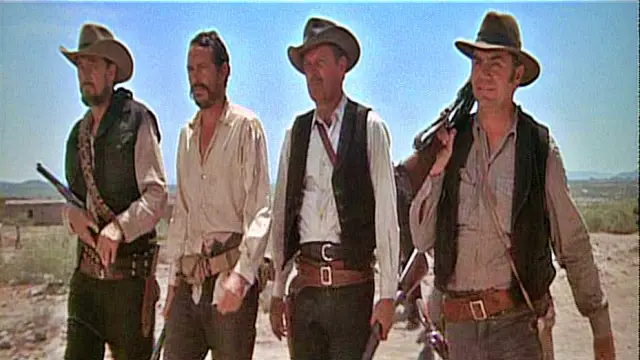Pauline Kael once memorably described the impact of The Wild Bunch upon the Western genre as new wine that exploded the bottle. The fine mesh of history, legend, and style that had previously sustained this specifically American brand of myth had received a crucial blow in the shift of zeitgeist. Where the Westerns of the ’50s and ’60s had become increasingly complex and multi-faceted, they had never quite lost the formats that had made it the most popular of Hollywood genres.
They relied on action and were formed by schemes of morality dramatized minutely by the action portrayed on screen. Heroes could be dark and conflicted, their situations despairing and riddled with moral threats, but always the plots revolved back to the classic patterns where civilized life rolled on and the Westerner trotted off to unknown tracts.

The Genre’s Cultural Shift
The civilization celebrated by John Ford, weaving its threads through the wild, was at war not just with the Titans that were the heroes of the Westerns, but with the psychological responses of those watching them. Kids found heroes, men found what they might have been in another era, and women had Western heroes for whom masculinity was something restrained and dutiful—as opposed to the villains who were usually rampant personifications of macho strife let loose. Yet the genre began to be dismissed through an absurd sense of dress-up play that the shifting pop culture of the ’60s began to ridicule. As memorably articulated by Ratso Rizzo in Midnight Cowboy, by ’69 the cowboy had become what was then the lowest, most sniggering form of cultural expression: camp.
Yet it took some time for the Western to die, and ironically it was killed at the box office by certain films that rank among the best works of the genre. The consequence was an attempt to construct a new Western genre through the ’70s, based not in the formal garb of morality play and penny-dreadful action, but in a luxuriant search for authentic feeling and experience on the edge of burgeoning post-war society.
Leone and Peckinpah: The Last True Masters
The American tradition of the Western was appropriated by Italian cinema in the mid-’60s. Who would have guessed the innate similarity between Hercules and Wyatt Earp? Suddenly the Western was no longer just a vessel for specifically American myths, but for the world’s myths. Yet, outside of Sergio Leone’s founding works, the Spaghetti Western is largely a woeful genre that added to the sense of dress-up absurdity.
Leone and Sam Peckinpah were the genre’s final masters, and the last filmmakers to essay it in ritualistic form. Their Westerns are fetishist in their evocations of time and place, brushing aside back-lot hamlets, Technicolor fantasy, and censor-board intervention to luxuriate in a rough-hewn world of shanty towns, harsh sensuality, and eccentric yet accurate details.
Peckinpah’s Vision
Peckinpah’s works, particularly The Wild Bunch, are studies of life-lust that articulate the general state of American manhood of their time. The Wild Bunch begs for pools of beauty, moments of peace in sexual and psychic release, for respect to passing heroes. Mexico becomes an almost fantastical playground and psychic escape hatch in Peckinpah’s works, an anarchic Yang to America’s iron-horse and greenbacks Yin.
The Elegiacs: Later Works
Pat Garrett and Billy the Kid feels like the Kabuki remake of The Wild Bunch. It attempts to combine romantic nihilism with elegiac spirit, recasting the drama of Billy’s death. The film presents Billy, who has in the past fought for men of power, as sealing his fate in social rather than moral terms. In this frontier land, the Law is not a clear-cut set of guidelines for morality and order, but a selectively enforced, bought-and-sold force.
The Mud and Blood westerns that followed, including works like Bad Company, McCabe and Mrs. Miller, and The Missouri Breaks, were films dedicated much less to plot and expansive vision than to capturing elusive qualities of texture, mood, and character. Each can be described as a black comedy, taking highly ironic views of the birth of American venture capitalism.
Heaven’s Gate: The Final Statement
Heaven’s Gate represents both the culmination and the death knell of the revisionist Western. Despite its initial commercial failure and critical savaging, it emerges as a superb film that combines careful character study with epic scope. It’s the first Western in a long time to re-engage with the John Ford tradition, where the travails of heroes and villains are only an aspect of a much larger project.
The film builds relentlessly to a chaotic, terrible battle that represents the hardening of social conflict into fully-fledged war. This led to its description as the first Marxist Western, though it simply makes explicit themes long present in the genre. The spectacular finale presents perhaps the most heroically American vision of grassroots resistance ever filmed.
The Genre’s End
If the Western died, except for occasional revivals and self-conscious works, it was not finally because the genre itself could not adapt: it was simply that the audience for it would not. The psychological and social needs that the Western had once fulfilled had transformed, leaving these complex, challenging works speaking to an audience that had already moved on.

